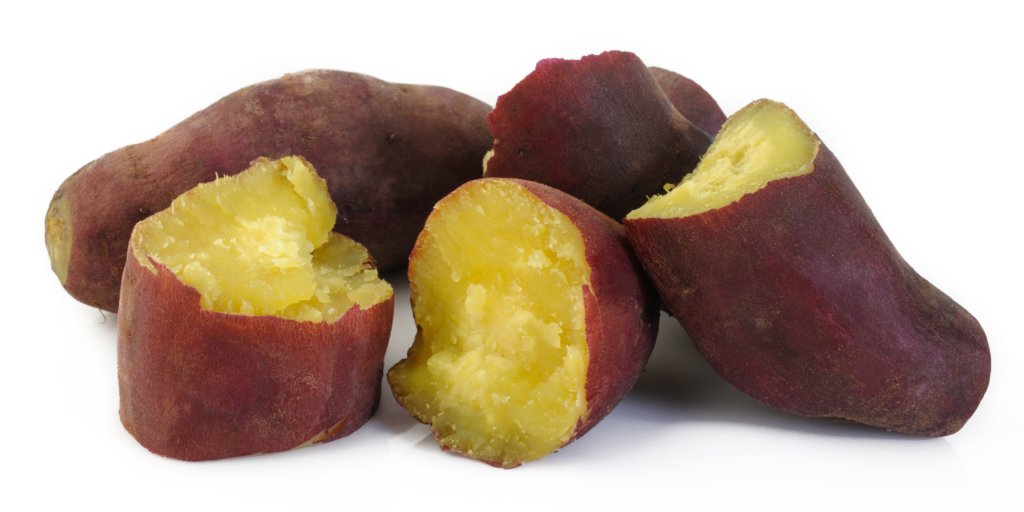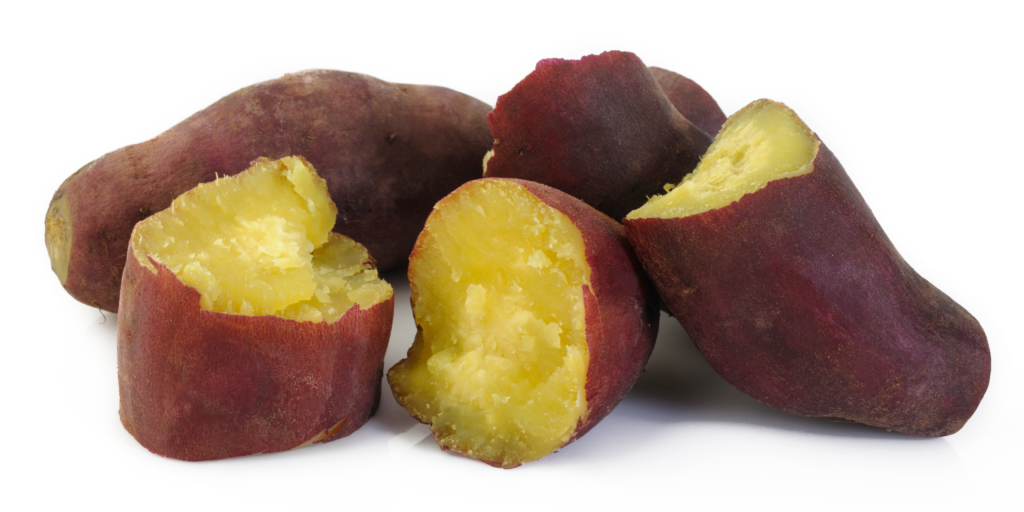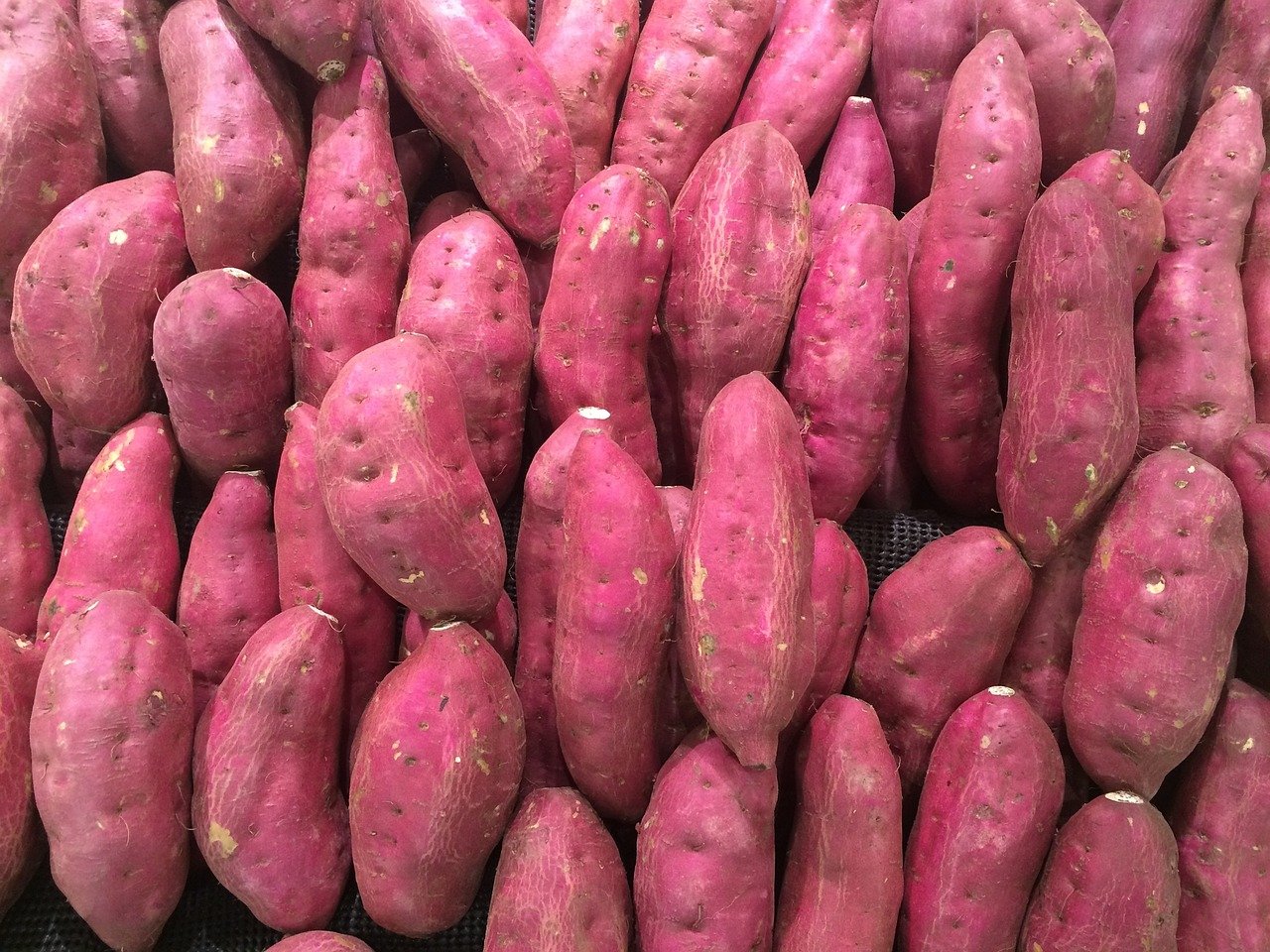
Wondering “How Long to Boil Sweet Potatoes” to achieve that flawless texture?
If you love sweet potatoes, you’re aware of the myriad methods to enjoy them, whether it’s baking, roasting, mashing, or pureeing.
Yet, the unique fluffiness and creaminess of a perfectly boiled sweet potato are incomparable.
Achieving this delightful texture requires knowing the precise boiling time for sweet potatoes to reach perfection.
Understanding the Benefits of Sweet Potatoes
Sweet potatoes are not only delicious, but they also come with a wide range of health benefits.
They are a nutrient-dense root vegetable that is packed with vitamins, minerals, and antioxidants:
1. Rich in vitamins and minerals: Sweet potatoes are an excellent source of fiber, pottasium and vitamins A, C, and E.
Vitamin A is important for maintaining healthy skin and good vision, while vitamin C boosts the immune system and helps in collagen production.
Vitamin E is an antioxidant that protects the body against free radicals. Potassium is essential for maintaining proper heart and muscle function, and fiber aids digestion.
2. High in antioxidants: Sweet potatoes contain a variety of antioxidants, including beta-carotene, which gives them their vibrant orange color.
Antioxidants help protect the body against damage caused by free radicals, which may cause chronic diseases even cancer.
3. Promote gut health: The fiber content in sweet potatoes promotes a healthy gut by acting as a prebiotic, which feeds the beneficial bacteria in your gut.
This helps to maintain a healthy balance of gut flora and can improve digestion.
4. Blood sugar regulation: Despite their natural sweetness, sweet potatoes have a low glycemic index.
They also contain complex carbohydrates that are digested more slowly, providing a steady release.
5. Support eye health: The high vitamin A content in sweet potatoes is important for maintaining good eye health. It helps protect the cornea and supports overall vision, particularly in low light conditions.
Whether boiled, baked, mashed, or roasted, these versatile root vegetables are a delicious and nutritious addition to any meal.
So next time you’re at the grocery store, be sure to grab a few sweet potatoes and start reaping the benefits for your overall health and wellbeing.
Preparation Tips for Perfectly Boiled Sweet Potatoes

If you’re ready to dive into the world of perfectly boiled sweet potatoes, we’ve got some preparation tips that will help you achieve that fluffy, creamy texture you’re craving.
Here are our top tips for preparing sweet potatoes that will leave you satisfied every time:
1. Choose the right sweet potatoes: When it comes to boiling sweet potatoes, it’s important to start with the right ones.
Look for sweet potatoes that are firm and free from any bruises or soft spots. Opt for medium-sized potatoes as they will cook more evenly and won’t take too long to boil.
2. Give them a good scrub: Before boiling your sweet potatoes, make sure to give them a good scrub under cold water.
You can also peel the potatoes if you prefer, but keeping the skin on can help retain their nutrients.
3. Cut them into even-sized pieces: To ensure that your sweet potatoes cook evenly, it’s best to cut them into similar-sized pieces. Aim for cubes or chunks that are around 1-2 inches in size.
4. Use a large pot and plenty of water: When boiling sweet potatoes, it’s important to use a large pot to accommodate all the pieces without overcrowding them.
Fill the pot with enough cold water to completely submerge the potatoes.
5. Season the water: While sweet potatoes have a natural sweetness, boiling them in plain water can leave them tasting a bit bland.
To enhance their flavor, consider adding a pinch of salt to the water. This will help bring out the natural sweetness of the potatoes and give them a little extra flavor.
6. Start with cold water: It’s best to start with cold water when boiling sweet potatoes. This allows them to cook evenly from the inside out.
Place the sweet potatoes in the pot, cover them with cold water, and then bring the water to a boil.
With these preparation tips in mind, you’ll be well on your way to perfectly boiled sweet potatoes. Just remember to choose the right potatoes, give them a good scrub, cut them into even-sized pieces, use a large pot with plenty of water, season the water, and start with cold water.
These simple steps will help you achieve that fluffy, creamy texture that will take your sweet potato dishes to the next level.
How Long to Boil Sweet Potatoes: The Optimal Time and Method
Boiling sweet potatoes may seem like a simple task, but the optimal time and method can make all the difference in achieving that fluffy, creamy texture.
So, how long should you boil your sweet potatoes to get that perfect consistency? Well, it depends on the size and type of sweet potato you’re working with.
For Medium-Sized Potatoes
For medium-sized sweet potatoes, a general rule of thumb is to boil them for about 15-20 minutes.
Start by placing your sweet potatoes in a pot of cold water, making sure they’re fully submerged. Then boil them.
Once the water reaches a boil, reduce the heat to medium-low and let the sweet potatoes simmer until they’re tender.
You can test for doneness by inserting a fork or knife into the thickest part of the potato – if it goes in easily, they’re done!
For larger Sweet Potatoes
If you’re working with larger sweet potatoes, you may need to increase the cooking time to around 25-30 minutes.
It’s important to adjust the boiling time based on the size of your sweet potatoes to ensure that they’re cooked all the way through without being overdone.
Method
In terms of method, boiling sweet potatoes with their skin on can help retain their nutrients and flavor. Once they’re cooked, the skin can easily be peeled off or left on, depending on your preference.
If you prefer a softer skin, simply peel the sweet potatoes after they’ve been boiled. On the other hand, if you enjoy the slightly chewy texture of the skin, you can leave it on.
To enhance the natural sweetness of your boiled sweet potatoes, you can add a touch of butter, honey, or cinnamon to the cooked potatoes.
This will give them an extra depth of flavor and make them even more satisfying.
Remember, the optimal boiling time and method may vary based on personal preference and the specific recipe you’re using.
Feel free to experiment and adjust the boiling time to achieve your desired texture. With a little practice and these tips in mind, you’ll be able to boil sweet potatoes to perfection every time.
Checking and Testing Your Boiled Sweet Potatoes

Once you’ve boiled your sweet potatoes for the recommended time, it’s important to check and test them to ensure they’re cooked to perfection.
There are a few key indicators to look for to determine if your sweet potatoes are ready to be enjoyed.
Use a Fork
First, you can use a fork or knife to gently pierce the thickest part of the sweet potato. If the utensil goes in smoothly and easily, with little resistance, that’s a good sign that your sweet potatoes are tender and ready to be enjoyed.
On the other hand, if there’s still some resistance or the utensil doesn’t easily slide in, your sweet potatoes may need a few more minutes of boiling time.
Squeeze Gently
Another way to check the doneness of your sweet potatoes is to give them a gentle squeeze.
They should be soft to the touch, with a slight give when pressed. If they feel firm or are still hard in the center, they need more time to cook.
Color
Color can also be an indicator of doneness. When sweet potatoes are fully boiled, they will have a vibrant orange color throughout.
If you notice any parts that are still pale or have a different color, those areas may not be fully cooked.
Taste a Small Piece
Lastly, you can taste a small piece of the sweet potato to ensure it has the desired texture and flavor. It should be tender and easily mashable, with a creamy and smooth consistency.
If it’s still firm or has a starchy taste, continue boiling for a few more minutes.
Remember, the cooking time can vary based on the size and type of sweet potato, so it’s important to check and test them periodically to avoid undercooking or overcooking.
Trust your instincts and adjust the boiling time as needed to achieve your preferred texture.
Once your sweet potatoes have passed the checking and testing stage, you can remove them from the heat and drain the water.
Now that you know how to check and test your boiled sweet potatoes, you can confidently prepare them to perfection every time.
So go ahead and enjoy that fluffy, creamy texture that will take your sweet potato dishes to the next level of deliciousness.
Serving Suggestions for Boiled Sweet Potatoes
Now that you’ve mastered the art of boiling sweet potatoes to achieve that fluffy, creamy texture, it’s time to explore some delicious serving suggestions.
Boiled sweet potatoes can be enjoyed on their own as a nutritious and satisfying side dish, or they can be used as a base for a variety of flavorful recipes.
Here are some serving suggestions that will take your boiled sweet potatoes to the next level:
1. Sweet and Savory Mash: Mash your boiled sweet potatoes with a touch of butter, a sprinkle of cinnamon, and a drizzle of honey for a delightful sweet and savory combination.
This simple and delicious side dish pairs well with roasted chicken, grilled steak, or roasted vegetables.

2. Sweet Potato Salad: Cut your boiled sweet potatoes into cubes and toss them with a light and tangy vinaigrette made with olive oil, lemon juice, and Dijon mustard.
Add some chopped fresh herbs like parsley or cilantro, and a sprinkle of crumbled feta cheese for a refreshing and flavorful salad that is perfect for picnics or potlucks.
3. Sweet Potato Soup: Blend your boiled sweet potatoes with vegetable or chicken broth, onions, garlic, and your favorite spices to create a velvety smooth sweet potato soup.
Top it off with a dollop of Greek yogurt or sour cream, and a sprinkle of fresh herbs for a comforting and nutritious meal.
4. Sweet Potato Fries: Cut your boiled sweet potatoes into thick fries and toss them with olive oil, salt, and your favorite spices such as paprika or cumin.
Bake them in the oven until crispy and golden brown for a healthier alternative to traditional french fries. Serve them as a side dish or enjoy them as a tasty snack.

5. Sweet Potato Tacos: Fill warm tortillas with seasoned black beans, mashed boiled sweet potatoes, crunchy cabbage slaw, and a drizzle of creamy avocado sauce for a delicious and satisfying vegetarian taco.
These flavorful tacos are perfect for a meatless Monday dinner or a quick and easy weeknight meal.
Remember, the possibilities are endless when it comes to serving boiled sweet potatoes. Get creative and experiment with different flavors and ingredients to discover your own favorite combinations.
Whether you’re enjoying them as a side dish, soup, salad, or even in tacos, boiled sweet potatoes are sure to add a burst of flavor and a healthy dose of nutrients to any meal.
So go ahead and get cooking, and savor the goodness of perfectly boiled sweet potatoes!
Common Mistakes While Boiling Sweet Potatoes and How to Avoid Them
Boiling sweet potatoes may seem like a simple task, but there are a few common mistakes that can easily be made. To ensure that your sweet potatoes come out perfectly every time, here are some common mistakes to avoid:
1. Overcooking: One of the biggest mistakes people make when boiling sweet potatoes is overcooking them. This can result in mushy and waterlogged potatoes that lack the desired texture.
To avoid this, make sure to keep an eye on the boiling time and check the doneness periodically by inserting a fork or knife into the thickest part of the potato.
If it easily slides in with little resistance, they’re done.
2. Undercooking: On the other hand, undercooking sweet potatoes can leave them hard and unpleasant to eat.
To avoid this, make sure to cook them for the recommended amount of time, based on their size and type. If you’re unsure, it’s better to err on the side of slightly overcooking rather than undercooking.
You can always check the doneness and continue boiling for a few more minutes if needed.
3. Unevenly sized pieces: Cutting your sweet potatoes into uneven-sized pieces can result in some pieces being undercooked while others are overcooked.
To ensure even cooking, make sure to cut your sweet potatoes into similar-sized pieces. Aim for cubes or chunks that are around 1-2 inches in size.
4. Overcrowding the pot: It’s important to give your sweet potatoes enough space to cook properly.
Overcrowding the pot can result in uneven cooking and may extend the boiling time. Make sure to use a large pot that can accommodate all the pieces without overcrowding them.
5. Neglecting to season the water: Boiling sweet potatoes in plain water can leave them tasting a bit bland. To enhance their flavor, make sure to season the water with a pinch of salt.
This will help bring out the natural sweetness of the potatoes and give them a little extra flavor.
By avoiding these common mistakes and following the tips and guidelines mentioned earlier in this post, you’ll be well on your way to boiling sweet potatoes to perfection every time.
So go ahead and give it a try – you’ll be rewarded with that fluffy, creamy texture that makes sweet potatoes so irresistible.
Happy boiling!
Related Articles:
Cooking Tips and Tricks for Perfectly Cooked Great Northern Beans Every Time
How to Perfectly Blanch Green Beans in Five Simple Steps
As an Amazon Associate, I earn commission from qualifying purchases.





